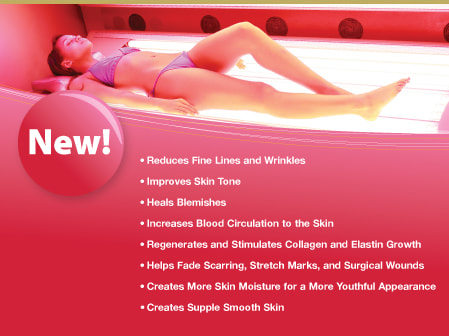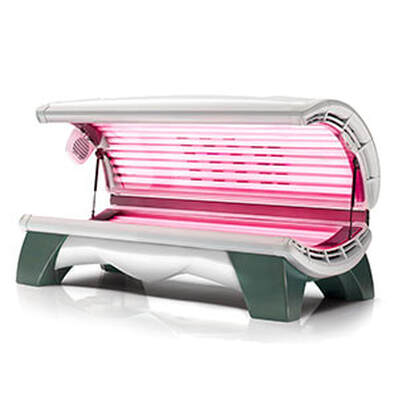What is Red Light Therapy
Red light therapy uses red, low-level wavelengths of light. Red Light Therapy produces a biochemical effect that boosts the amount of energy in cells and stimulates collagen, elastin, and blood-flow. This helps cells function more efficiently, become rejuvenated, and repair damage throughout the body. There are close to no negative effects of red light therapy and many skin and overall health benefits.
Benefits:
Reduces signs of aging and acne – Red light therapy encourages lymphatic drainage which helps the body cleanse itself of impurities which cause acne and redness.
Improves the look of scars, stretch marks, and cellulite – Red light therapy helps with blood circulation, this helps to smooth the skin and deliver nutrients to damaged areas of the body.
Reduces pain, inflammation, and sunburns – Red light helps to open the blood vessels and aid in blood flow, helping with both pain and inflammation.
How does red light therapy supposedly work?
Red light therapy is thought to work by acting on the “power plant” in your body’s cells called mitochondria. With more energy, other cells can do their work more efficiently, such as repairing skin, boosting new cell growth and enhancing skin rejuvenation. More specifically, certain cells absorb light wavelengths and are stimulated to work.
Red light therapy may work in skin health to:
Stimulate collagen production, which gives skin its structure, strength and elasticity.
Increase fibroblast production, which makes collagen. Collagen is a component of connective tissue that builds skin.
Increase blood circulation to the tissue.
Reduce inflammation in cells.
Red light therapy is promoted as a treatment for some common skin conditions, including:
Improve wound healing
Reduce stretch marks
Reduce wrinkles, fine lines and age spots
Improve facial texture
Improve psoriasis, rosacea and eczema
Improve scars
Improve sun-damaged skin
Improve hair growth in people with androgenic alopecia
Improve acne
Psoriasis
Skin Rejuvenation
Cellulite
Arthritis
Nerve Pain and Nerve Regeneration
Anxiety and Depression
Improved skin appearance and elasticity
Fibromyalgia
Improved Muscle Performance and Recovery
Tendinopathies
Scientific Evidence
There have been numerous research studies conducted on red light therapy, and the overall conclusion of the research is that it can be an effective treatment option for a variety of conditions.
If you are using red light therapy to improve your skin tone, minimize the visible signs of aging, and heal sun damage, you can expect to undergo red light therapy in 20-minute sessions, 3 to 5 times each week for one to four months. Then once a week for maintenance.
Red light therapy uses red, low-level wavelengths of light. Red Light Therapy produces a biochemical effect that boosts the amount of energy in cells and stimulates collagen, elastin, and blood-flow. This helps cells function more efficiently, become rejuvenated, and repair damage throughout the body. There are close to no negative effects of red light therapy and many skin and overall health benefits.
Benefits:
Reduces signs of aging and acne – Red light therapy encourages lymphatic drainage which helps the body cleanse itself of impurities which cause acne and redness.
Improves the look of scars, stretch marks, and cellulite – Red light therapy helps with blood circulation, this helps to smooth the skin and deliver nutrients to damaged areas of the body.
Reduces pain, inflammation, and sunburns – Red light helps to open the blood vessels and aid in blood flow, helping with both pain and inflammation.
How does red light therapy supposedly work?
Red light therapy is thought to work by acting on the “power plant” in your body’s cells called mitochondria. With more energy, other cells can do their work more efficiently, such as repairing skin, boosting new cell growth and enhancing skin rejuvenation. More specifically, certain cells absorb light wavelengths and are stimulated to work.
Red light therapy may work in skin health to:
Stimulate collagen production, which gives skin its structure, strength and elasticity.
Increase fibroblast production, which makes collagen. Collagen is a component of connective tissue that builds skin.
Increase blood circulation to the tissue.
Reduce inflammation in cells.
Red light therapy is promoted as a treatment for some common skin conditions, including:
Improve wound healing
Reduce stretch marks
Reduce wrinkles, fine lines and age spots
Improve facial texture
Improve psoriasis, rosacea and eczema
Improve scars
Improve sun-damaged skin
Improve hair growth in people with androgenic alopecia
Improve acne
Psoriasis
Skin Rejuvenation
Cellulite
Arthritis
Nerve Pain and Nerve Regeneration
Anxiety and Depression
Improved skin appearance and elasticity
Fibromyalgia
Improved Muscle Performance and Recovery
Tendinopathies
Scientific Evidence
There have been numerous research studies conducted on red light therapy, and the overall conclusion of the research is that it can be an effective treatment option for a variety of conditions.
If you are using red light therapy to improve your skin tone, minimize the visible signs of aging, and heal sun damage, you can expect to undergo red light therapy in 20-minute sessions, 3 to 5 times each week for one to four months. Then once a week for maintenance.


